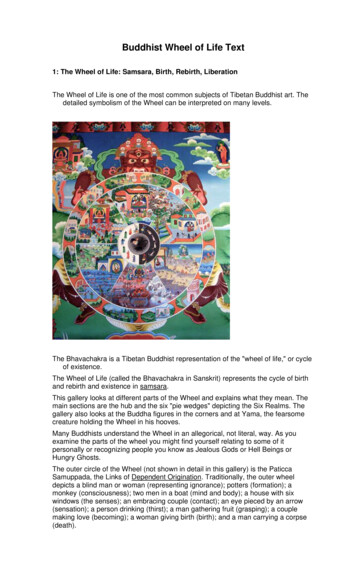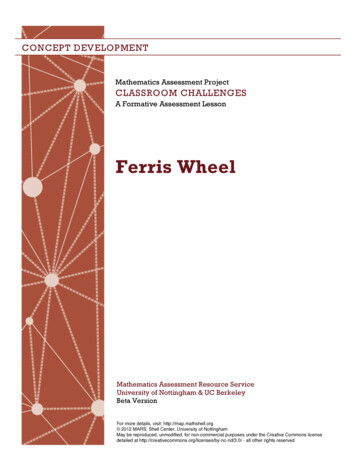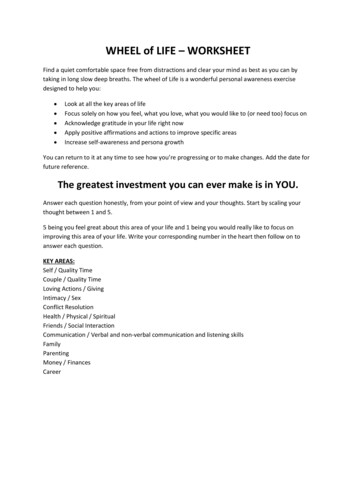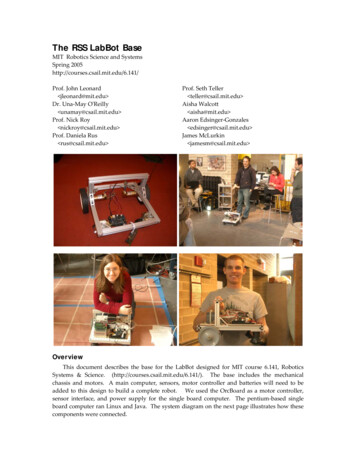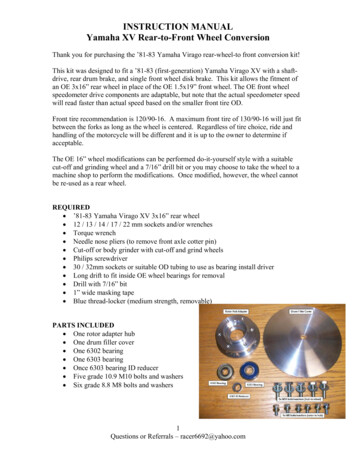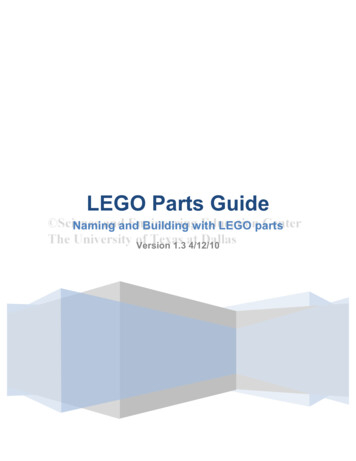
Transcription
www.positivepsychologyprogram.com Positive Psychology Practitioner‘s ToolkitThe Wheel of LifeHappinessAssessment15-25 min.ClientNoSubjective well-being involves different components: life satisfaction (global judgments of one’slife), satisfaction with important life domains (e.g., recreation), positive affect (experiencingpleasant emotions and moods), and low levels of negative affect (experiencing few unpleasantemotions and moods) (Diener, 2000).An often used tool to address a client’s satisfaction with important life domains is “The Wheel ofLife” (Whitworth, Kimsey-House, & Sandahl, 1998; Dean, 2004). This tool requires that the clientfirst identifies specific life domains (career development, relationships, leisure time, etc.) and thenrates these domains on a scale of one to ten (from not at all satisfied, to completely satisfied).After rating one’s personal domains, opportunities for increasing satisfaction in each domain arediscussed.GoalThe goal of this tool is to assess the client’s perceived satisfaction/dissatisfaction in the differentdomains of life. Practitioners typically use this tool with clients in the discovery session in aneffort to gage a client’s sense of life fulfilment.Advice This exercise can be used to clarify priorities for goal-setting, allowing the client to planso their current life becomes closer to their desired life: increasing balance between thedifferent life domains. Note that it is important to first understand what “balance” looks likefor the client before trying to make this determination based on the results of this exercise.Not everyone is going to want the different domains to be in perfect balance. It all dependson the client’s values. Note that “balance” is not necessarily reflected by the wheel. In fact, most often, the wheelis a firm reminder of how “unbalanced” a client’s life is. Therefore, this exercise may serve toinform clients of any gap between perceived “balance” and reality. The Wheel of Life is not a picture of the past. It is a snapshot taken in the moment andbecause of this, it is subject to change. The wheel provides the client with data in the “now,”and the practitioner may use that information to point out the gaps between what is truetoday and what the client wants for the future. When used on a regular basis, this tool is excellent to help your clients to see how farthey have come. Repeated measures allow clients to monitor their progress in perceivedlife balance. Periodic balance checks can highlight useful patterns and facilitate clientbehavioural change. A client may also ask someone who knows them well to complete the scores for them. Attimes, it may be helpful for a client to understand an outsider’s perspective. Preferably, thisis someone who the client trusts and whose opinion the client values.[1]
www.positivepsychologyprogram.com Positive Psychology Practitioner‘s Toolkit When clients are unsatisfied with specific life domains, they may want to drastically improvetheir satisfaction with these domains. Especially for perfectionistic clients, the awarenessof low levels of satisfaction may automatically trigger a need to drastically increase them.However, setting unrealistic goals is likely to cause frustration and lower well-being. Forinstance, several studies have shown that when people have idealized positive fantasies,their motivation and energy to achieve these goals dramatically decreases (e.g. Kappes &Oettingen, 2011). The practitioner should assist the client in setting reasonable targets forimproving well-being. Instead of motivating them to work toward a 10, the practitioner shouldhelp clients to shift the focus from being the best to simply being better, offering thempermission to strive without the burden of emotional self-flagellation. A solution-focusedstrategy may work well here. For example, if a client rates his relationship satisfaction withhis wife a 5, the practitioner could ask: “What could you do this week to move your 5 up toa 6?”. This tool can also be used in a group-setting. Group members may be asked to completethe exercise before attending the first session and to repeat the exercise during the courseof the program. Repeating the exercise will allow group members to acknowledge both thechanges that they are making and the growth that they are experiencing. Alternatively, the“life domains” may be replaced with “group values” (e.g. collaboration, honesty, etc.). In thisversion of the tool, the wheel can serve as a tool to monitor the extent to which the group isbehaving in line with group values.Suggested ReadingsDean, B. (2004). MentorCoach Foundation skills training manual. Baltimore: MentorCoach.Diener, E. (2000). Subjective well-being: The science of happiness, and a proposal for nationalindex. American Psychologist, 55, 34-43.Kappes, H.B., Stephens, E.J. & Oettingen, G. (2011). Implicit theories moderate the relation ofpositive future fantasies to academic outcomes. Journal of Research in Personality, 45, 269-278.Oishi, S., Diener, E., & Lucas, R. E. (2007). Optimal level of well-being: Can people be too happy?Perspectives on Psychological Science, 2, 346–360.Whitworth, L., Kimsey-House, H., & Sandahl, P. (1998). Co-active coaching. Palo Alto, CA:Davies-Black Publishing.[2]
www.positivepsychologyprogram.com Positive Psychology Practitioners ToolkitTool DescriptionInstructions (version 1: pre-defined life domains)Step 1Inform the client that The Wheel of Life allows you both to get a snapshot of how satisfied the client is in his/her life.In this version of the exercise there are ten pre-defined domains on the wheel: Money & FinanceCareer & WorkHealth & FitnessFun & RecreationEnvironmentCommunityFamily & FriendsPartner & LoveGrowth & LearningSpiritualityStep 2Ask the client to rate his/her level of satisfaction in each of the domains using the wheel on p.4 (Fig. 1). A score of 1indicates that you are not satisfied at all and a score of 10 means you are highly satisfied.Step 3After the client has rated each of the domains, ask him/her to connect the lines to form an inner wheel. This givesthe client an overview of the level of satisfaction in their life. For an example of a completed wheel, see Fig. 3 on p.9.Step 4Discuss with the client in what ways he/she would want to change the shape of the inner wheel. Which domainsdraw your attention?Step 5Once a domain is selected, proceed with the following questions: Why does this domain need attention? What would it take to raise your satisfaction by one score in this domain? What can you do to raise your satisfaction in this domain?[3]
www.positivepsychologyprogram.com Positive Psychology Practitioners ToolkitFig. 1: The Wheel of Life with pre-defined life domainsMONEY 098762&91010ITY5431LYMIFAMUNHEALTH & GRRCA91PARTNER & LOVENCE10109COMFINANTEONMRIVNE[4]
www.positivepsychologyprogram.com Positive Psychology Practitioners ToolkitInstructions (version 2: self-defined life domains)Step 1Inform the client that The Wheel of Life allows you both to get a snapshot of how satisfied the client is in his/her life.The client is invited to choose up to 10 categories to reflect different domains of his/her life. The practitioner mayoffer examples of life areas to help the client get started. Define the chosen life domains including a brief descriptionper domain below.Life Domain 1:Life Domain 2:Life Domain 3:Life Domain 4:Life Domain 5:[5]
www.positivepsychologyprogram.com Positive Psychology Practitioners ToolkitLife Domain 6:Life Domain 7:Life Domain 8:Life Domain 9:Life Domain 10:[6]
www.positivepsychologyprogram.com Positive Psychology Practitioners ToolkitStep 2Ask the client to enter the names of the life domains in the outer rim of the empty wheel displayed on p.8 (Fig. 2).Step 3Ask the client to rate his/her level of satisfaction in each of the domains using the wheel on p.8 (Fig. 2). A score of1 indicates that you are not satisfied at all and a score of 10 means you are highly satisfied.Step 4After the client has rated each of the domains, ask him/her to connect the lines to form an inner wheel. This givesthe client an overview of the level of satisfaction in their life. For an example of a completed wheel, see Fig. 3 on p.9.Step 5Discuss with the client in what ways he/she would want to change the shape of the inner wheel. Which domainsdraw your attention?Step 6Once an area is selected, proceed with the following questions: Why does this domain need attention? What would it take to raise your satisfaction by one score in this domain? What can you do to raise your satisfaction in this domain?[7]
www.positivepsychologyprogram.com Positive Psychology Practitioners ToolkitFig. 2: The Wheel of Life with self-defined life 67891099552101066[8]
www.positivepsychologyprogram.com Positive Psychology Practitioners ToolkitFig. 3: Example of a completed version of The Wheel of LifeMONEY 678DS97CREARE71015961748837912610HEALTH & TNER & LOVENCE10109COMFINAFUSPITNNMEIROENV[9]
The Wheel of Life Subjective well-being involves different components: life satisfaction (global judgments of one’s life), satisfaction with important life domains (e.g., recreation), positive affect (experiencing pleasant emotions and moods), and low levels of negative affect (experi
